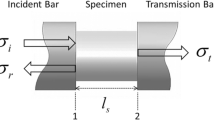Abstract
Pulse-shaping techniques are developed for both the loading and unloading paths of a split Hopkinson pressure bar (SHPB) experiment to obtain valid dynamic stress-strain loops for engineering materials. Front and rear pulse-shapers, in association with a momentum trap, are used to precisely control the profiles of the loading and unloading portions of the incident pulse. The modifications, ensure that the specimen deforms at the same constant strain rate under dynamic stress equilibrium during both loading and unloading stages of an experiment so that dynamic stress-strain loops can be accurately determined. Dynamic stress-strain loops with a constant strain rate for a nickel-titanium shape memory alloy and polymethyl methacrylate are determined using the modified SHPB. The modified momentum trap prevents repeated loading on a specimen without affecting the amplitude of the desired loading pulse and without damaging the bar at high stress levels.
Similar content being viewed by others
References
Chen, W., Wu, Q., Kang, J.H., andWinfree, N.A., “Compressive Superelastic Behavior of a NiTi Shape Memory Alloy at Strain Rates of 0.001–750 s−1,”International Journal of Solids and Structures,38,8989–8998 (2001).
Belyaev, S.P., Morozov, N.F., Razov, A.I., Volkov, A.E., Wang, L., Shi, S., Gan, S., Chen, J., andDong, X., “Shape-memory Effect in Titanium-Nickel After Preliminary Dynamic Deformation,”Materials Science Forum,394–395,337–340 (2002).
Liu, Y., Li, Y., andRamesh, K.T., “Rate Dependence of Deformation Mechanisms in a Shape Memory Alloy,”Philosophical Magazine A,82,2461–2473 (2002).
McNaney, J.M., Imbeni, V., Jung, Y., Papadopoulos, P., andRitchie, R.O., “An Experimental Study of the Superelastic Effect in a Shape-memory Nitinol Alloy Under Biaxial Loading,”Mechanics of Materials,35,969–986 (2003).
Gray, G.T., “Classic Split Hopkinson Pressure Bar Technique,”ASM Handbook, Vol. 8, Mechanical Testing and Evaluation, ASM International, Materials Park, OH (2000).
Gray, G.T. andBlumenthal, W.R., “Split Hopkinson Pressure Bar Testing of Soft Materials,”ASM Handbook, Vol. 8, Mechanical Testing and Evaluation, ASM International, Materials Park, OH (2000).
Kolsky, H., “An Investigation of the Mechanical Properties of Materials at Very High Strain Rates of Loading,”Proceedings of the Physical Society,B62,676–700 (1949).
Gong, J.C., Marlven, L.E. andJenkins, D.A., “Dispersion Investigation in the Split Hopkinson Pressure Bar,” Transactions of the ASME,Journal of Engineering Materials and Technology,112,309–314 (1990).
Parry, D.J., Walker, A.G., andDixon, P.R., “Hopkinson Bar Pulse Smoothing,”Measurement Science and Technology,6,443–446 (1995).
Zhao, H., Gary, G., andKlepaczko, J.R., “On the Use of a Viscoelastic Split Hopkinson Pressure Bar,”International Journal of Impact Engineering,19,319–330 (1997).
Chen, W., Zhang, B., andForrestal, M.J., “A Split Hopkinson Bar Technique for Low-impedance Materials,”Experimental Mechanics,39,81–85 (1999).
Chen, W., Lu, F., andZhou, B., “A Quartz-crystal-embedded Split Hopkinson Pressure Bar for Soft Materials,” EXPERIMENTAL MECHANICS,40,1–6 (2000).
Chen, W. andLuo, H., “Dynamic Compressive Responses of Intact and Damaged Ceramics from a Single Split Hopkinson Pressure Bar Experiment,” EXPERIMENTAL MECHANICS,44,295–299 (2004).
Christensen, R.J., Swanson, S.R., andBrown, W.S., “Split Hopkinson Bar Tests on Rocks Under Confining Pressure,”E-upxperimental Mechanics,12,508–513 (1972).
Nemat-Nasser, S., Isaacs, J.B., andStarrett, J.E., “Hopkinson Techniques for Dynamic Recovery Experiments,”Proceedings of the Royal Society, Series A,435,371–391 (1991).
Frew, D.J., Forrestal, M.J., andChen, W., “Pulse-shaping Techniques for testing Brittle Materials with a Split Hopkinson Pressure Bar,” EXPERIMENTAL MECHANICS42,93–106 (2002).
Bragov, A.M. andLomunov, A.K. “Methodological Aspects of Studying Dynamic Material Properties Using the Kolsky Method,”International Journal of Impact Engineering,16,321–330 (1995).
Chen, W. andRavichandran, G., “Dynamic Compressive Failure of a Glass Ceramic Under Lateral Confinement”Journal of the Mechanics and Physics of Solids,45,1303–1328 (1997).
Chen, W., Song, B., Frew, D.J., andForrestal, M.J., “Dynamic Small Strain Measurements of a Metal Specimen with a Split Hopkinson Pressure Bar,” EXPERIMENTAL MECHANICS43,20–23 (2003).
Frew, D.J., Forrestal, M.J., andChen, W., “A Split Hopkinson Pressure Bar Technique to Determine Compressive Stress-strain Data for Rock Materials,”EXPERIMENTAL Mechanics,41,40–46 (2001).
Song, B., Chen, W., andWeerasooriya, T., “Quasi-static and Dynamic Compressive Behaviors of a S-2 Glass/SC15 Composite,”Journal of Composite Materials,37,1723–1743 (2003).
Chen, W., Lu, F., Frew, D.J., andForrestal, M.J., “Dynamic Compressive Behavior of a Rigid Polyurethane Foam with Various Densities,” EXPERIMENTAL MECHANICS,42,65–73 (2002).
Song, B. andChen, W., “One-dimensional Dynamic Compressive Behavior of EPDM Rubber,”Transactions of the ASME, Journal of Engineering Materials and Technology,125,294–301 (2003).
Chen, W., Lu, F., andCheng, M., “Tension and Compression Tests of Two Polymers Under Quasi-static and Dynamic Loading,”Polymer Testing,21,113–121 (2002).
Chen, W., Lu, F., Frew, D.J., andForrestal, M.J., “Dynamic Compression Testing of Soft Materials,”Transactions of the ASME, Journal of Applied Mechanics,69,214–223 (2002).
Song, B., Chen, W., Yanagita, T., and Frew, D.J., “Confinement Effects on the Dynamic Compressive Properties of an Epoxy Syntactic Foam,” Composite Structures, doi: 10.1016/j.compstruct.2004.07.011.
Author information
Authors and Affiliations
Rights and permissions
About this article
Cite this article
Song, B., Chen, W. Loading and unloading split hopkinson pressure bar pulse-shaping techniques for dynamic hysteretic loops. Experimental Mechanics 44, 622–627 (2004). https://doi.org/10.1007/BF02428252
Received:
Accepted:
Issue Date:
DOI: https://doi.org/10.1007/BF02428252




